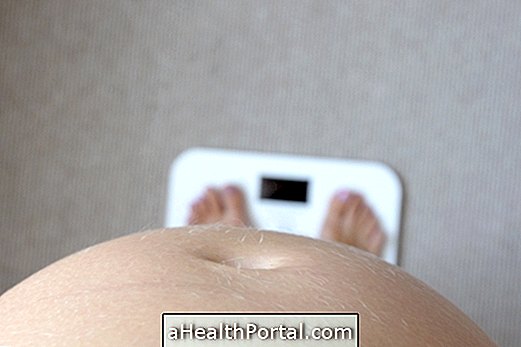The first ultrasound should be performed as early as the 1st trimester of pregnancy, between 11 and 14 weeks, but this ultrasound still does not allow the sex of the baby to be discovered, which is usually only possible around week 20.
Ultrasound, also known as ultrasound or ultrasound is a medical examination that allows the observation of images in real time, which must be performed by all pregnant as it helps to know how the baby is developing inside the uterus.
This type of examination does not cause pain and is safe for both the pregnant and the baby, as it does not use any type of radiation and its realization has no side effects and is therefore considered a non-invasive examination.

How much ultrasound should be done in pregnancy
The most common is to be advised to do 1 ultrasound per quarter, however, if the doctor has any suspicion or if any examination indicates a possible change in pregnancy, it may be recommended to repeat the ultrasound more regularly, so there is not a certain number of ultrasound during pregnancy.
Thus, in addition to the first ultrasound performed between weeks 11 and 14, at the very least, an ultrasound should also be performed in the 2nd trimester of pregnancy, near week 20, when it is already possible to determine the sex of the baby and a 3rd ultrasound, between the 34 and at 37 weeks of gestation.
Diseases and problems that can be detected
Ultrasound should be performed more than once throughout pregnancy because over the trimesters, and depending on the growth and development of the baby, will allow to identify different problems in the baby:
In the first trimester of pregnancy
In the first trimester of pregnancy, the ultrasound is used to:
- Identify or confirm the baby's gestational age;
- Determine how many babies are in the belly, this being especially important for women who have had fertility treatments;
- Determine where the implantation of the embryo occurred in the uterus.
In the event of vaginal bleeding, this test is essential to rule out the possibility of miscarriage and pregnancy outside the uterus. See what symptoms may indicate a possible miscarriage.

In the 2nd trimester of pregnancy
Already in the second trimester of pregnancy, with the development and growth of the baby the exam already manages to provide a greater amount of information, such as:
- Presence of some genetic problems like Down syndrome for example. For this, an ultrasound exam is performed called Nuchal Translucency, a measurement that is performed in the region of the nape of the fetus.
- Determination of malformations that the baby may have;
- Determination of the sex of the baby, which is usually only possible around the 20th week of gestation;
- Assessment of the developmental state of the baby's organs, including the heart;
- Evaluation of baby growth;
- Determination of the location of the placenta, which at the end of pregnancy should not cover the cervix, if this happens there is a risk that the baby can not be born in normal birth.
In addition, microcephaly is another disease that can be identified in this period, because if it is present the baby's head and brain are smaller than expected. Learn more at Understanding Microcephaly and what the consequences are for your baby.
In the 3rd trimester of pregnancy
- New assessment of baby's growth and development;
- Determination and evaluation of amniotic fluid level;
- Location of the placenta.
In addition, performing this examination during this time may be especially necessary when there are non-point and unexplained bleeding.
What types of Ultrasound can be performed
Depending on the need, there are different types of ultrasound that can be performed, which provide more or less information about the baby. Thus, the different types of ultrasound that can be used are:
- Intravaginal Ultrasound: It should only be done at the beginning of gestation up to 11 weeks and sometimes serves to confirm pregnancy at the place of the blood test. This is performed internally by placing a device called a transducer in the vagina and is recommended from the 5th week of gestation.
- Morphological Ultrasound: consists of an ultrasound with more detailed images than the previous one, that allow the evaluation of the growth of the baby and the development of its organs.
- 3D Ultrasound: has even better images than the morphological ultrasound and the fact that the image is given in 3D increases the sharpness. With this type of ultrasound, it is possible to better screen for possible malformations in the baby, and it is also possible to see the features of your face.
- 4D Ultrasound: Ultrasound combines 3D image quality with baby's movements in real time. So your 3D real time image lets you do a detailed analysis of the baby's movements.
Both 3D Ultrasound and 4D Ultrasound should be performed between weeks 26 and 29, as it is during this time that the image is expected to be sharper. Learn more about this in 3D Ultrasound and 4D show details of the baby's face and identify diseases.
All pregnant women should perform at least 3 ultrasounds during pregnancy, sometimes 4 if an intravaginal ultrasound is performed early in pregnancy. But, each pregnancy is different and it is the obstetrician who must indicate how many tests are needed.
In most cases, the morphological ultrasound is used, using only 3D or 4D ultrasound if there are any suspicions of problems or malformations in the baby, or if the mother wants to see the features of her face.























